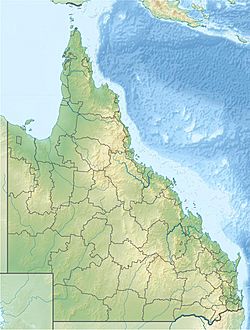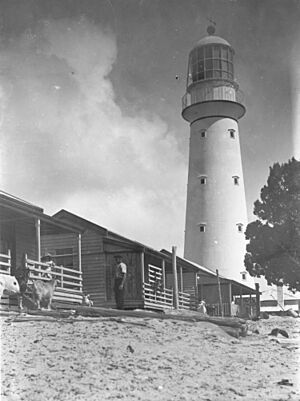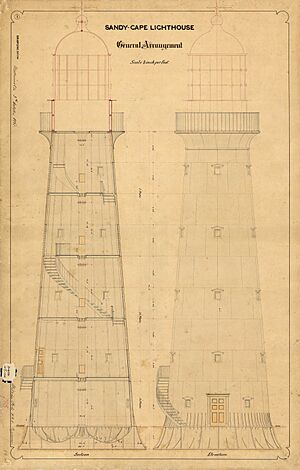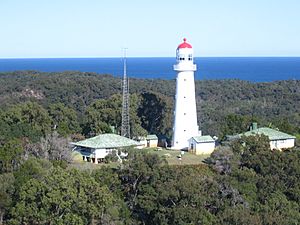Sandy Cape Light facts for kids
 |
|
| Sandy Cape Light, 2007 | |
|
|
|
| Location | Sandy Cape Queensland Australia |
|---|---|
| Coordinates | 24°43′47.9″S 153°12′31.18″E / 24.729972°S 153.2086611°E |
| Year first constructed | 1870 |
| Automated | 1995 |
| Foundation | concrete |
| Construction | cast iron |
| Tower shape | conical tower with balcony and lantern |
| Markings / pattern | white tower and lantern, red lantern dome |
| Height | 85 feet (26 m) |
| Focal height | 421 feet (128 m) |
| Original lens | first order Chance Brothers |
| Current lens | VRB-25 |
| Intensity | 160,000 cd |
| Range | 21 nautical miles (39 km; 24 mi) |
| Characteristic | Fl W 10s. |
| Admiralty number | K2932 |
| NGA number | 111-10488 |
| ARLHS number | AUS-148 |
The Sandy Cape Light is an important lighthouse found on Sandy Cape. This is the very northern tip of Fraser Island in Queensland, Australia. It stands about 6 kilometers (3.7 miles) southwest of the island's northeast end. This lighthouse is the tallest in Queensland. It was built in 1870. It was the second major lighthouse built in Queensland after the state was formed in 1859.
Sandy Cape Light is special because it was one of the first lighthouses in Australia made from pre-made cast iron parts. These parts were then bolted together on site. Only two lighthouses in Queensland were built this way. The other one is its sister lighthouse, Bustard Head Light.
Contents
History of Sandy Cape Light
Building a Lighthouse for Queensland
The government of Queensland started in 1859. In 1862, the first Portmaster, Commander George Poynter Heath, was chosen. By 1864, two groups decided where new lighthouses were needed. Both groups agreed that Sandy Cape definitely needed a lighthouse. Joseph Brady, Queensland's Engineer for Harbours and Rivers, also strongly suggested this location in 1865.
The parts for the lighthouse tower were ordered from Kitson & Co. in Leeds, England. William Pole from Kitson & Co. designed the tower. The top part of the lighthouse, called the lantern, and its equipment came from Chance Brothers in Birmingham, England. All the materials arrived in Brisbane by 1867.
The brothers John and Jacob Rooney from Maryborough, Queensland won the bid to build the tower. They offered to do it for £4524. Sandy Cape Light was the first of many lighthouses they built. They also built Cape Bowling Green Light, Cowan Cowan Point Light, Cape Capricorn Light, Lady Elliot Island Light, and Booby Island Light.
How the Lighthouse Was Built
Materials from Brisbane and cement from Sydney arrived by ship. They were then moved onto barges. Horses pulled these barges on trolleys along a 1.2 kilometer (0.75 mile) wooden rail. This rail went up 50 meters (164 feet). The last 50 meters (164 feet) of materials were lifted by a horse-powered whim.
The Sandy Cape Light was supposed to be the first lighthouse built by the new Queensland government. However, the Bustard Head Light was finished first in 1868. The Sandy Cape Light was officially lit in May 1870.
Early Light and Keepers
The first light system was a revolving one from Chance Brothers. It showed one white flash every two minutes. This light could be seen for 20 nautical miles (37 kilometers). The light came from an Argand lamp that burned colza oil. A clockwork machine made the light turn. This machine had to be wound up regularly.
Houses were also built for the head lighthouse keeper and three assistant keepers, along with their families. These houses were made of timber with weatherboard walls and iron roofs.
Changes Over the Years
- In 1875, the light started using Kerosene instead of oil.
- In 1915, the lighthouse station was taken over by the Commonwealth government.
- The light was improved in 1917 and again in 1923. During one of these upgrades, the light changed to an incandescent mantle using vaporized kerosene.
In the 1930s, the lens was replaced with a smaller 4th order Chance Brothers lens. The lighthouse also started using electricity. Around this time, the keepers' cottages were rebuilt. Most other buildings at the station were also constructed then. Septic tanks were added in the 1960s. A special roadway was built in the 1970s. A brick engine room was added in 1974. The kitchens in the houses were updated in the 1980s.
Automation and Modern Use
In 1995, the lighthouse was changed to use solar power. It became automated, meaning no keepers were needed anymore. The 4th order lens was replaced with a modern VRB-25 light system. In 1997, the keepers left the station for good. The lighthouse was then given back to the Queensland Government. Now, the Queensland Parks and Wildlife Service manages it. They have a ranger who works there.
In 2001, a remote area power supply (RAPS) was put in to power the houses. It uses both solar and wind power. There is also a diesel generator for backup. However, the wind turbine has not been used since October 2002.
How Sandy Cape Light Works Today
The light now flashes white once every ten seconds (Fl.W. 10 s). It can be seen for 21 nautical miles (39 kilometers). The light source is a 100 Watt, 10 Volt VRB-25 lantern. It shines with an intensity of 160,000 cd. The power comes from a photovoltaic system. This means a battery is charged by solar power.
Lighthouse Structures
The Lighthouse Tower
The lighthouse tower is round and shaped like a cone. It stands 26 meters (85 feet) tall. It is made of pre-made cast iron plates and painted white. The base has wide parts that sit on a 4 meter (13 feet) concrete foundation. The tower is about 7 meters (23 feet) wide at the bottom. It gets narrower towards the top, reaching about 4 meters (13 feet) wide below the lantern.
Inside, the lighthouse has five floors. A spiral iron staircase with cast iron steps connects them. The stairs are attached to the inner walls. The lighthouse has two entrances. One is at the very bottom. The other is about 3 meters (10 feet) above the ground. You can reach this higher entrance by an outside staircase. The bottom entrance leads to the ground floor. Here, you can see different old maritime items, including the old 4th order Chance Brothers lens. The top entrance leads into the main tower. Above the doorway, you can see the words "Kitson & Co LEEDS 1866" cast into the iron.
The top of the tower has an iron balcony that sticks out. It has a simple iron railing. Above the balcony is the lantern room. This room has a cast iron walkway supported by fancy iron brackets. The lantern room is also made of cast iron. It has a rounded roof covered with copper and painted bright red.
Other Buildings at the Station
Around the lighthouse, there is a workshop and other buildings. The living areas include two one-story houses for the keepers. One was for the head keeper and one for the assistant keeper. They are made of timber frames with fibro cladding. They have timber strips covering the joins and timber frames for doors and windows. The windows have a fixed top pane, a sliding bottom pane, and louvers.
Near the houses, there is a chicken yard and a shelter. Other service buildings are about 80 meters (262 feet) southeast of the lighthouse. These include a powerhouse, a garage, and a large fuel storage building. The workshop, office, and garage are timber-framed. They have painted fiber cement and cover battens. These were built at the same time as the houses. The newer powerhouse and fuel store are made of bricks. They have concrete foundations and stainless steel roofs with a central vent. Their doors and window frames are metal.
There is also a small picket fenced cemetery south of the station. It has several stone headstones.
Visiting Sandy Cape Light
The Australian Maritime Safety Authority operates the light. The Queensland Parks and Wildlife Service manages the site. It is part of the Great Sandy National Park. You can reach Fraser Island by ferry from Hervey Bay or Inskip Point. Inskip Point is north of Rainbow Beach, Queensland. You can also take a chartered flight via Maroochydore Airport. To get to the lighthouse station, you need a four-wheel drive vehicle or you can take a long hike.
Heritage Status
The Sandy Cape Light was added to the Queensland Heritage Register in 1998. This means it is an important historical site.






